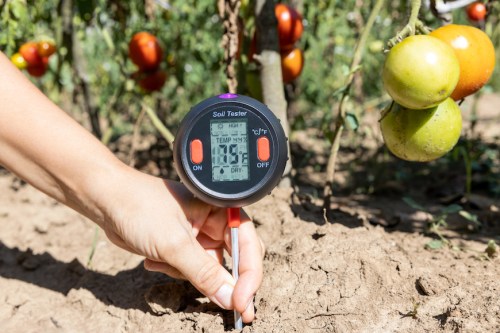Our editors independently select these products. Making a purchase through our links may earn Well+Good a commission
If you have to dig through a foot of snow, it’s not the best time to root your begonias. But when it comes to spring planting, you’ll need to consider more than just the weather. Soil temperature definitely affects plant growth. Drop seeds into too cold (or hot) ground, and you’ll be none to happy with the results.
Experts in This Article
horticulturalist for Earth’s Ally.
“Plants won’t grow well if soil temperatures are either too high or too low, especially during early stages of plant growth,” says says Angelo Randaci, horticulture expert and master gardener at Earth’s Ally. “This is one of the most accurate ways to determine when it is safe to plant. If soil temperature is too cold, seedling may not germinate. Low temperatures reduce moisture and nutrient uptake.”
And different plants will require different soil temperatures for seedling germination and plant growth. “Cool season vegetables such as lettuce will germinate at temperatures above 32 degrees but will develop slowly,” says Randaci. “As soil temperatures warm, your germination rate will increase.”
How to measure your soil temperature for planting
The process is relatively simple once you have the proper tool in hand. Purchase a Soil Thermometer ($23) and simply follow the instructions. Mostly likely, the instructions will tell you to stick the thermometer into the soil at the same depth that you will sow your seeds.
“Early morning is the best time to test because that is when the soil is coldest,” says Randaci. “You can use a meat thermometer to measure soil temperatures. Make sure it can test the temperatures up to 40 degrees and lower. Place it in the ground three or four inches deep. Leave it in the ground for five minutes or so. Temperatures should be at least 45 degrees to be safe to plant.”

Need some additional tips on how to handle soil temperature? Here are three other important things to keep in mind.
1. Know what temperatures are required
In general, seed germination is best when soil temperatures are warm at about 70 degrees and up to 85 degrees for plants such as beans and tomatoes,” says Randaci. “Cuttings root best also at soil temperatures of 70 degrees or so.”
Another way to know the assignment? Make sure to read the instructions! If you have seed packets, check to see what they say about best germination temperatures. You can also research online and read information in seed catalogs.
2. Blanketing your soil can warm them up
Sounds pretty intuitive, right? Randaci recommends covering the soil with mulch or a plastic sheet in order to raise temperatures. “This will allow the sun to heat the soil during the day, and hold heat in at night,” he says.
3. Location, location, location
Certain bedding situations can turn up the heat a little quicker, according to Randaci. Soil in raised beds, in particular, warm up sooner than in-ground beds. And if you’re planting during a Springtime with unpredictable weather, no reason to rush them outside. “Start plants indoors and plant them when soil temperatures warm,” Randaci says.
Oh hi! You look like someone who loves free workouts, discounts for cult-fave wellness brands, and exclusive Well+Good content. Sign up for Well+, our online community of wellness insiders, and unlock your rewards instantly.
Sign Up for Our Daily Newsletter
Get all the latest in wellness, trends, food, fitness, beauty, and more delivered right to your inbox.
Got it, you've been added to our email list.








